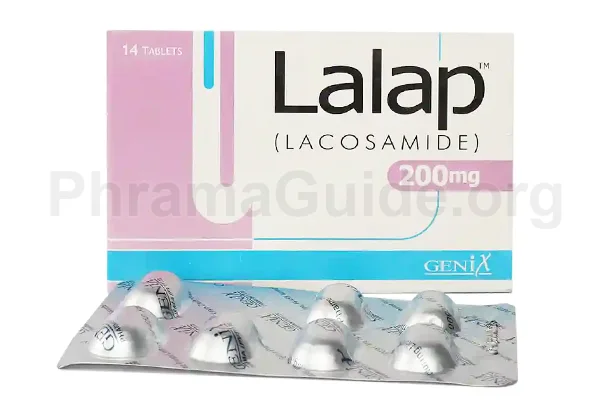Lalap Tablet is a medication used to treat certain types of seizures in people with epilepsy. It is typically prescribed when other seizure medications have not provided sufficient control of seizures. The following are some common uses and indications of the Lalap Tablet:
- Partial-Onset Seizures: Lalap tablet is commonly used to manage partial-onset seizures in individuals with epilepsy. Partial-onset seizures are characterized by abnormal electrical activity that starts in one part of the brain.
- Adjunctive Therapy: Lalap tablet is often used as an add-on (adjunctive) treatment when other antiepileptic medications alone are not providing adequate seizure control.
- Focal Seizures: Lalap tablet may be used for focal seizures, which are a type of partial-onset seizure that starts in a specific area of the brain. It can be used to help reduce the frequency and severity of these seizures.
Off-label Uses of Lalap Tablet
- Neuropathic Pain: Some studies have explored the potential use of Lalap tablet in treating certain types of neuropathic pain, which is pain that arises from damage to or dysfunction of the nervous system.
- Mood Disorders: Lalap tablet may have mood-stabilizing properties, and it has been trialed as an adjunctive treatment for bipolar disorder. However, this is an area that requires further research.
- Other Types of Seizures: While the Lalap tablet is primarily used for partial-onset seizures, there may be cases where healthcare providers consider it for other types of seizures in conjunction with other medications.
- Status Epilepticus: In certain cases of prolonged or recurring seizures that do not respond to first-line treatments, Lalap tablet may be considered as an adjunctive therapy.
- Migraine Prevention: Lalap tablet may be effective in preventing migraines, particularly in cases where other treatments have not been successful.
- Other Neuropsychiatric Conditions: Some studies have investigated the potential benefits of Lalap tablets in conditions such as schizophrenia and attention-deficit/hyperactivity disorder (ADHD). However, these uses are still in the early stages of research.

What is Lalap?
Lalap is one of the leading brands of Lacosamide, manufactured and marketed by Genix Pharmaceuticals (Pvt) Ltd, Pakistan.
Lalap Tablet’s Alternatives : Other Similar Brands
The following are some alternative brands of Lalap and their manufacturers.
- Nurosa : Helix Pharma (Pvt) Ltd, Pakistan.
- Lacolep : Hilton Pharmaceuticals (Pvt)Ltd, Pakistan.
- Atcomid : Atco Laboratories (Pvt) Ltd, Pakistan.
- Lacolit : Searle Pakistan Ltd.
- Lacosbar : Barrett Hodgson (Pvt) Ltd, Pakistan.
- Lecomide : Rasco Pharma (Pvt) Ltd, Pakistan.
- Vimpex : MAQ Pharma, Pakistan.
- Xamogine : Mass Pharma (Pvt) Ltd, Pakistan.
Lalap : Available Formulations and Strengths
Presently, Lalap is available in tablet form.
- Lalap Tablet : 50mg, 100mg, and 200mg strengths.
Who Should Not Use Lalap? – Contraindications
Lalap tablets have certain contraindications, meaning there are specific conditions or situations in which Lalap tablets should not be used.
- Hypersensitivity: Individuals who have a known allergy or hypersensitivity to Lacosamide or any of its components should not use this medication.
- Second-Degree or Higher Atrioventricular (AV) Block: Lalap tablet can affect the electrical conduction system of the heart. It is contraindicated in individuals with second-degree or higher AV block unless they have a functioning pacemaker.
- Severe Liver Impairment: Lalap tablet is metabolized in the liver, and in cases of severe hepatic (liver) impairment, the drug’s dosage may need to be adjusted or an alternative treatment considered.
- Pregnancy: While Lalap tablet is generally considered safe during pregnancy, it should only be used if the potential benefits outweigh the potential risks. It’s important for pregnant individuals to discuss the risks and benefits with their healthcare provider.
- Breastfeeding: Lalap tablet is known to pass into breast milk, so it’s recommended that breastfeeding be avoided while taking this medication.
- Children and Adolescents Under 18 Years of Age: The safety and effectiveness of Lalap tablets in children and adolescents under 18 years old have not been established, so it is generally not recommended for use in this age group.
- Status Epilepticus: Lalap tablet is not typically used to treat status epilepticus (a prolonged seizure or a series of seizures without recovery between them). Immediate medical attention is required in this situation.
- Heart Rhythm Disorders (Bradyarrhythmias): Lalap tablet can affect heart rhythm, so it may be contraindicated in individuals with certain heart rhythm disorders.
What is the Recommended Daily Dosage of Lalap Tablet?
Lalap Tablet Dose for Adults:
- 200 to 400 mg, taken in two divided doses.
- The dosage may be increased by 100 mg daily, with changes made usually once a week.
- The maximum daily dose is 600 mg.
Lalap Tablet Monotherapy for partial-onset seizures:
- 100 mg twice daily (200 mg per day).
Lalap Tablet Adjunctive therapy for partial-onset seizures:
- 50 mg twice daily (100 mg per day).
Lalap Tablet Adjunctive therapy for primary generalized tonic-clonic seizures:
- 50 mg twice daily (100 mg per day).
How Lalap Works?
Lalap tablet is an antiepileptic drug that works by modulating voltage-gated sodium channels. Voltage-gated sodium channels are proteins that allow sodium ions to flow into neurons. When these channels are open, they allow the neuron to fire an electrical impulse.
Lalap tablet works by enhancing the slow inactivation of voltage-gated sodium channels. This means that the channels are less likely to open, which makes it more difficult for the neuron to fire an electrical impulse.

Leave A Comment